Barnes & Noble
Barnes & Noble, Inc., is a Fortune 500 company, the largest retail bookseller in the United States, and a leading retailer of content, digital media and educational products in the country. The company operates 640 retail stores (as of January 1, 2016) in all 50 U.S. states.[5]
Barnes & Noble operates mainly through its Barnes & Noble Booksellers chain of bookstores and the company's headquarters are at 122 Fifth Avenue in the Ladies' Mile Historic District in Manhattan in New York City.[6]
After a series of mergers and bankruptcies in the American bookstore industry since the 1990s, Barnes & Noble stands as the United States' last remaining national bookstore chain.[7][8] Previously, Barnes and Noble operated the chain of small B. Dalton Booksellers stores in malls until they announced the liquidation of the chain. The company is known for large retail outlets, many of which contain a café serving Starbucks coffee. Most stores sell books, magazines, newspapers, DVDs, graphic novels, gifts, games, toys, music, and Nook e‑readers and tablets.
History
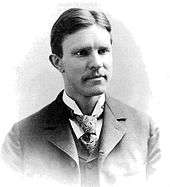
1886–1929
Barnes & Noble originated in 1886 with a bookstore called Arthur Hinds & Company, located in the Cooper Union Building in New York City.[9][10] In the fall of 1886, Gilbert Clifford Noble, a then-recent Harvard graduate from Westfield, Massachusetts, was hired to work there as a clerk.[11] In 1894, Noble was made a partner, and the name of the shop was changed to Hinds & Noble.[12] In 1901, Hinds & Noble moved to 31–35 W. 15th Street.[13]
In 1917, Noble bought out Hinds and entered into a partnership with William Barnes, son of his old friend Charles; the name of the store was changed accordingly to Barnes & Noble.[14][15] Charles Barnes had opened a book-printing business in Wheaton, Illinois in 1873; William Barnes divested himself of his ownership interest in his father's firm just before his partnership with Noble and it would go on to become Follett Corporation. Although the flagship store once featured the motto "founded in 1873," the C. M. Barnes-Wilcox Company never had any connection to Barnes & Noble other than the fact that both were partly owned (at different times) by William Barnes.
1930–1969
In 1930, Noble sold his share of the company to William Barnes' son John Wilcox Barnes.[16] Noble died on June 6, 1936, at the age of 72.[17] In the long history of the bookstore, the namesake partnership was a brief interlude of thirteen years.

In 1932, at the height of the Great Depression, the bookstore was moved to a flagship location on 18th Street and Fifth Avenue,[18] which served as such until it closed in 2014. The Noble family retained ownership of an associated publishing business, and Barnes & Noble opened a new publishing division in 1931.[16] In 1940, the store was one of the first businesses to feature Muzak; it underwent a major renovation the following year.[19] That decade the company opened stores in Brooklyn and Chicago.[20] William Barnes died in 1945, at the age of 78 and his son John Wilcox Barnes assumed full control.[20] The company underwent a significant expansion in the 1950s and 1960s, opening an additional retail store on Twenty-third Street in Manhattan and shops near the City University of New York, Harvard and other Northeast college campuses.[21] John Barnes died in 1964 and the company was sold to the conglomerate Amtel in 1966.[22]
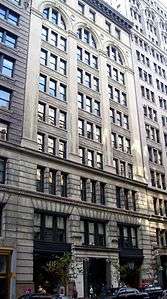
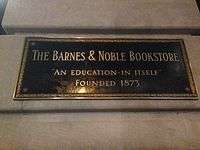
1970s
The business was purchased in 1971, by Leonard Riggio for $1.2 million.[21] By then it had been badly mismanaged over the prior two years and consisted only of "a significantly reduced wholesale operation and a single retail location—the store at 105 Fifth Avenue."[21] In 1974, Barnes & Noble became the first bookstore to advertise on television and a year later, the company became the first bookseller in America to discount books, by selling The New York Times best-selling titles at 40% off the publishers' list price.[23] During the 1970s and 1980s, Barnes & Noble opened smaller discount stores, which were eventually phased out in favor of larger stores. They also began to publish their own books to be sold to mail-order customers. These titles were primarily affordable reissues of out-of-print titles and selling them through mail-order catalogs allowed Barnes & Noble to reach new customers nationwide.[23]
In November 1974, in response to a question from a member of the studio audience, the British twin brothers Norris McWhirter and Ross McWhirter, who were editors of the British-produced Guinness Book of Records, claimed on the BBC One television programme Record Breakers that the Fifth Avenue store of Barnes and Noble had overtaken that of London's Foyles bookshop to become the world's biggest bookstore.[24]
1980s–1990s
Barnes & Noble continued to expand throughout the 1980s and in 1986, purchased the primarily shopping mall-based B. Dalton chain from Dayton Hudson for an estimated $275 million to $300 million.[25] The last B. Dalton stores were slated to close in January 2010.[26] In 1989, Barnes and Noble had purchased the 22-store chain Bookstop. Solveig Robinson, author of The Book in Society: An Introduction to Print Culture, wrote that the purchase "gave [Barnes and Noble] the necessary know-how and infrastructure to create what, in 1992, became the definitive bookselling superstore."[27] The acquisition of the 797 B. Dalton bookstores turned the company into a nationwide retailer, and by the end of fiscal year 1999, the second-largest online bookseller in the United States.[26] B&N's critics claim that it has contributed to the decline of local and independent booksellers.[28]
Before Barnes & Noble created its web site, it sold books directly to customers through mail-order catalogs. It first began selling books online in the late 1980s, in an early generation venue called Trintex, a joint venture between Sears and IBM, but the company's website was not launched until May 1997.[29] According to the site, it now carries over 2 million titles.[30]
2000s
In 2002, Leonard Riggio's brother Stephen Riggio was named CEO, a position he held until 2010.[31] The Barnes & Noble Review, an online literary site, was launched in October 2007. It featured book reviews, columns, and interview from critics and authors such as Michael Dirda, John Freeman, A.C. Grayling, Ezra Klein, Paul LaFarge, Mark Sarvas, Dava Sobel, Neal Stephenson, Stephen King, and Greil Marcus.[32] Music critic Robert Christgau has also written essays for the site.[33]
Video games and related items were sold in the company's GameStop retail outlets from 1999 until late 2004, when the division was spun off by distributing its 59% stake in GameStop to stakeholders of Barnes & Noble's, making it an independent company.[34]
2010s
Website president William Lynch was named CEO in 2010. He is credited with helping launch the company's electronic book store and overseeing the introduction of its electronic book reader, the Nook. Many observers saw his appointment as underscoring the importance of digital books to Barnes & Noble's future. Steve Riggio stayed on as vice chairman.[35] Lynch resigned in mid-2013,[36] and he was replaced by Chief Financial Officer Michael Huseby early the next year.[37] Following the spinoff of Barnes and Noble Education, Huseby departed to head the new firm; his place was filled in mid-2015 by Ronald Boire,[38][39] who departed one year later.[40]
After the bankruptcy and closure of its chief competitor, Borders Group, in 2011,[41] Barnes & Noble became the last remaining national bookstore chain in America.[7][8] This followed a series of mergers and bankruptcies in the American bookstore industry since the 1990s, which also saw the demise of Waldenbooks, Barnes & Noble's own subsidiary B. Dalton, and Crown Books, among others. Barnes & Noble's largest physical bookstore rival is now Books-A-Million, which does not operate in the Western US. Barnes & Noble also faces competition from general retailers, especially from Amazon.com, and from regional and independent booksellers.
At the same time, Barnes & Noble has reduced its overall presence; it closed its original flagship store in early 2014,[42] and mid-2014 saw it spinning off the Nook Media division.[43]
Publishing
Barnes & Noble publishes some of the books it sells, inexpensively reprinting non-copyrighted titles or acquiring the U.S. or English language rights from another publisher. In addition, Barnes & Noble commissions reprint anthologies and omnibus editions using in-house editors.
One of these titles, The Gentle Art of Verbal Self-Defense by Suzette Haden Elgin, has sold over 250,000 copies.[29] The reissued edition of The Columbia History of the World by John Garrity, for example has sold over 1 million copies.[29]
Since then, the company has expanded its publishing operation. This expansion was aided by the company's 2001 acquisition of SparkNotes, an educational website and publishing company.[44] Further expansions of the company's publishing business include the purchase of Sterling Publishing in 2003.[29]
From around 1992 through early 2003, Barnes & Noble released a series of literary classics for adults and children under the imprint Barnes & Noble Classics. Originally available only in hardcover, most titles came in a black or cream-colored dust jacket edition. In 2003, Barnes & Noble revamped and expanded its line of literature classics, releasing books in hardcover, mass market, and trade paperback editions. In addition, Barnes & Noble has a second paperback series called the Barnes & Noble Library of Essential Reading.[45]
Food service
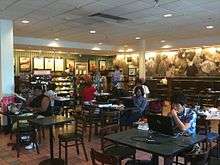
The first store to feature a café serving Starbucks beverages was in Springfield, New Jersey, in 1993. Since then, most stores have been amended or constructed specifically to feature a café serving Starbucks beverages, Harney & Sons or Tazo Tea, FIJI Bottled Water, bakery goods from The Cheesecake Factory, candy from Godiva Chocolatiers, sandwiches and other specialty products. Although the cafés are owned and operated by Barnes & Noble, servers follow Starbucks' standards in beverage preparation. The Barnes & Noble membership card is accepted to receive a discount on any café related goods.[46] Starbucks Rewards and gift cards are not accepted at Barnes & Noble cafés.
In 2004, Barnes & Noble began offering Wi-Fi in the café area of selected stores, using SBC FreedomLink (now the AT&T Wi-Fi network). All stores currently offer Wi-Fi, an effort which was completed in 2006. Since July 27, 2009, Wi-Fi is offered for free to all customers.[47]
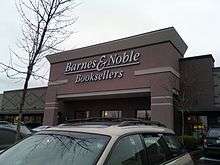
In 2016, Barnes & Noble announced plans during an investor conference to open four concept stores featuring restaurants twice the size of their cafés that would offer better food, wine, and beer. The restaurants, which are planned to open in fiscal year 2017, are expected to drive sales growth; should sales meet expectations, additional concept stores could open and stores with enough space to accommodate the restaurant could have the restaurants incorporated there as well. Company officials planned to open the first such stores in New York, Minnesota, California, and Virginia.
The Barnes & Noble restaurants are expected to include a waitstaff and a full menu for breakfast, lunch, and dinner.[48]
Community involvement
Barnes & Noble hires community business development managers to engage in community outreach. These managers' responsibilities include organizing in-store events, such as author appearances, children's storytimes and book groups. Community business development managers also work closely with local schools and groups to promote literacy and the arts. For example, Barnes & Noble sponsors a children's summer reading program that promotes literacy and puts over 2 million books into the hands of the children each year.[49] Barnes & Noble also hosts bookfairs, which raise funds for schools and libraries and an annual holiday book drive to collect books for disadvantaged children. Barnes & Noble stores collected and donated nearly 1.5 million books to more than 650 local charities across the country that provide services to disadvantaged children during the 2014 Holiday Book Drive.[50] To promote nationwide literacy among 1st to 6th graders and encourage more reading during the summer, Barnes & Noble has implemented a summer challenge: if children read eight books and write about their reading, Barnes & Noble will give the reader a free book.[51]
Barnes & Noble Nook
Barnes & Noble Nook (styled NOOK) is a suite of e-book readers developed by the company,[52] based on the Android platform. The first device was announced in the United States on October 20, 2009 and was released November 30, 2009, for $259.[53] On June 21, 2010, Barnes & Noble reduced the Nook's price to $199, as well as launched a new Wi-Fi-only model, for $149, and released a Nook colored touch screen for $249.[54]
The Nook competes with the Amazon Kindle, Kobo eReader, and other e-reader offerings and color tablets used sometimes as readers, such as Apple's iBooks for iOS devices. Various Nook models feature a 6-inch, 7-inch, or larger touchscreen.[55] Version 1.3 of the Nook introduced Wi-Fi connectivity, a web browser, a dictionary, chess, and sudoku games, and a separate, smaller color touchscreen that serves as the primary input device. The Nook also features a Read in Store capability that allows visitors to stream and read any book for up to one hour while shopping in a Barnes & Noble bookstore. According to a June 2010 CNet article, the company planned to expand this feature to include periodicals in the near future.[56] The color version of the Nook introduced a 7-inch color touchscreen and the ability to view at a portrait or landscape orientation.[57]
On April 30, 2012, Microsoft invested $300 million for a 17.6% stake in Nook, which valued the business at about $1.7 billion.[58]
In November 2012, the technology publications Mashable and Techdirt criticized the license agreement with which Barnes & Noble sells ebooks to consumers, pointing out that the rights to re-download a purchased ebook expire when the customer's credit card expires, and a valid credit card must be added to the account to restore this functionality.[59][60]
In June 2014, Barnes & Noble had previously announced that it would spin off its Nook Digital division into a separate publicly traded company,[43][61] but as of 2016, Nook remains a part of Barnes & Noble. That same month, the company announced a partnership with Samsung Electronics to make Nook tablets, as the bookseller moved forward with plans to revamp its digital business.[62] Samsung and Barnes & Noble introduced the Samsung Galaxy Tab 4 Nook 7.0 in August 2014, followed by the Samsung Galaxy Tab 4 Nook 10.1 in October 2014. In December 2014, Barnes & Noble announced that it had ended its Nook partnership with Microsoft by buying back its stake.[63] In September 2015, Samsung and Barnes & Noble introduced the Samsung Galaxy Tab S2 NOOK.[64]
In March 2016, Barnes & Noble announced it would close the Nook App Store and Nook Video and in the UK close the Nook Store on March 15.[65] It will continue to sell ebooks as well as digital magazines and newspapers in the US.
College bookstores
In August 2015, Barnes & Noble announced the completion of the separation of its Retail and College businesses. Barnes & Noble Education, Inc. is now an independent public company and the parent of Barnes & Noble College, trading on the New York Stock Exchange under the ticker symbol, "BNED". Barnes & Noble College Booksellers, previously owned by company chairman Leonard Riggio, operated the self-proclaimed "world's largest bookstore" on Fifth Avenue and 18th Street in New York City, from 1932 to 2014. This flagship store carried a large variety of textbooks, medical and legal books, and medical supplies, in addition to the various trade titles carried at the company's main stores.[66]
See also
- Amazon.com
- Book Stacks Unlimited
- Books-A-Million
- Bookselling
- Borders Group
- Follett Corporation
- List of bookstore chains
References
- ↑ "Management Team". Barnes & Noble. Retrieved September 25, 2015.
- 1 2 "Barnes & Noble, Inc. Financials". google.com. Retrieved September 16, 2015.
- 1 2 "Barnes & Noble, Form 10-K, Annual Report, Filing Date Jun 27, 2012" (PDF). secdatabase.com. Retrieved February 6, 2013.
- ↑ http://www.4-traders.com/BARNES-NOBLE-INC-11858/company/. Retrieved 2016-10-19. Missing or empty
|title=(help) - ↑ "For Investors" at barnesandnobleinc.com. Retrieved January 1, 2016.
- ↑ "National Sponsorships and Donations." Barnes & Noble. Retrieved on January 29, 2010
- 1 2 DePillis, Lydia (July 10, 2013). "Barnes & Noble's troubles don't show why bookstores are doomed. They show how they'll survive.". The Washington Post. Retrieved October 30, 2013.
it's now the only national bookstore chain in the country
- 1 2 Townsend, Matt (July 10, 2013). "Bookstores Not Dead Yet as Riggio Bets on Barnes & Noble". Bloomberg Businessweek. Archived from the original on September 16, 2013. Retrieved October 30, 2013.
the last national bookstore chain
- ↑ "Barnes & Noble to Move." The Bookseller and Stationer, January 1. 1922 p. 13
- ↑ The Noble Legacy: The Story of Gilbert Clifford Noble, Cofounder of the Barnes & Noble and Noble & Noble Book Companies by Betty N. Turner. iUniverse: 2006 ISBN 0595374786, 9780595374786 page 71
- ↑ The Noble Legacy: The Story of Gilbert Clifford Noble, Cofounder of the Barnes & Noble and Noble & Noble Book Companies by Betty N. Turner. iUniverse: 2006 ISBN 0595374786, 9780595374786 page 65
- ↑ The Noble Legacy: The Story of Gilbert Clifford Noble, Cofounder of the Barnes & Noble and Noble & Noble Book Companies by Betty N. Turner. iUniverse: 2006 ISBN 0595374786, 9780595374786 page 101
- ↑ "Barnes & Noble to Move." The Bookseller and Stationer, January 1. 1922 p. 13
- ↑ The Noble Legacy: The Story of Gilbert Clifford Noble, Cofounder of the Barnes & Noble and Noble & Noble Book Companies by Betty N. Turner. iUniverse: 2006 ISBN 0595374786, 9780595374786 page 151
- ↑ Blair, Cynthia. "1917: First Barnes & Noble Bookstore Opens in Manhattan". Newsday. Archived from the original on October 1, 2007. Retrieved 2007-08-01.
- 1 2 The Late Age of Print: Everyday Book Culture from Consumerism to Control by Theodore G. Striphas. Columbia University Press: 2009. 978-0-231-14814-6 p. 62
- ↑ The Noble Legacy: The Story of Gilbert Clifford Noble, Cofounder of the Barnes & Noble and Noble & Noble Book Companies by Betty N. Turner. iUniverse: 2006 ISBN 9780595374786 page 153
- ↑ Eisenstadt, Peter, ed. (2004). "The Encyclopedia of New York State". Syracuse University Press. p. 1266.
- ↑ The Late Age of Print: Everyday Book Culture from Consumerism to Control by Theodore G. Striphas. Columbia University Press: 2009. 978-0-231-14814-6 p. 64
- 1 2 Barnes & Noble: Groundbreaking Entrepreneurs by Kayla Morgan. Abdo Publishing: 2000 ISBN 9781604537581 p. 78
- 1 2 3 The Late Age of Print: Everyday Book Culture from Consumerism to Control by Theodore G. Striphas. Columbia University Press: 2009. 978-0-231-14814-6 p. 65
- ↑ Reluctant Capitalists: Bookselling and the Culture of Consumption by Laura J. Miller. University Of Chicago Press: 2007 p. 47
- 1 2 "Barnes & Noble History". Barnes & Noble. Archived from the original on May 9, 2008. Retrieved 2008-06-13.
- ↑ Record Breakers. Presented by Roy Castle. Co-presented by Norris and Ross McWhirter. BBC 1. Broadcast on Tuesday November 19, 1974.
- ↑ Miller, Stephen (2015-10-13). "Bruce Dayton, CEO of Retailer That Became Target, Dies at 97". Bloomberg News. Retrieved 2015-11-15.
- 1 2 "BarnesAndNobleInc.com" (PDF). Retrieved 2012-09-18.
- ↑ Robinson, Solveig. The Book in Society: An Introduction to Print Culture. Broadview Press, November 15, 2013. ISBN 1770484310, 9781770484313. p. 260.
- ↑ St. John, Warren (July 6, 1999). "Barnes & Noble's Epiphany". Wired. Archived from the original on May 6, 2008. Retrieved 2008-05-19.
- 1 2 3 4 "Barnes & Noble History". Barnes & Noble Inc. Retrieved September 4, 2010.
- ↑ About Barnes & Noble.com; Barnes&Noble.com; Accessed September 4, 2010
- ↑ "Barnes & Noble Booksellers". Barnesandnobleinc.com. Retrieved 2012-09-18.
- ↑ "The Barnes & Noble Review Celebrates One Year As Top Literary Destination". Business Wire. October 8, 2008. Retrieved October 14, 2013.
- ↑ Gross, Jason (July 2, 2010). "Robert Christgau and the End of the Consumer Guide". PopMatters. Retrieved October 14, 2013.
- ↑ Jeffrey A. Trachtenberg (October 5, 2004). "Barnes & Noble Pares GameStop". The Wall Street Journal.
- ↑ "Barnes & Noble names website head William Lynch as CEO". USA Today. March 18, 2010.
- ↑ Brown, Abram (July 8, 2013). "Barnes & Noble CEO Lynch Out After Nook Woes Deepen". Forbes. Retrieved August 20, 2013.
- ↑ "Barnes & Noble points Michael P. Huseby CEO". Market Watch. January 8, 2014.
- ↑ http://www.nytimes.com/2015/07/03/business/media/barnes-noble-names-ronald-boire-of-sears-canada-ceo.html
- ↑ "Barnes & Noble Completes Spin-Off of Barnes & Noble Education".
- ↑ "Barnes & Noble Says CEO Boire 'Not a Good Fit' and Will Step Down".
- ↑ Leopold, Todd (September 12, 2011). "The death and life of a great American bookstore". CNN. Retrieved October 30, 2013.
- ↑ Pasquarelli, Adrianne (January 7, 2014). "Barnes & Noble closes the book on Fifth Ave. store". Crain's New York Business. Retrieved 2015-09-01.
- 1 2 Franzen, Carl. "Barnes & Noble is splitting into two companies: one for Nooks and one for books".
- ↑ "Barnes & Noble inc - BKS Quarterly Report (10-Q) Item 1: Financial Statements". Edgar Online. 18 June 2001. Retrieved 2008-02-05.
- ↑ "Barnes & Noble Library of Essential Reading". Barnes & Noble. Retrieved April 8, 2012.
- ↑ "Membership Program: Frequently Asked Questions". Retrieved February 27, 2013.
- ↑ Colker, David. "Internet wants to be free at Barnes & Noble", Los Angeles Times, July 29, 2009
- ↑ http://fortune.com/2016/06/23/barnes-and-noble-wine/
- ↑ Community page at Barnes & Noble Booksellers; Accessed September 5, 2010
- ↑ Holiday Book Drive; Barnes & Noble Booksellers; Accessed January 22, 2015
- ↑ "Summer Reading Challenge". Barnes & Noble website. Archived from the original on April 30, 2009. Retrieved 2009-05-08.
- ↑ Jeffrey A. Trachtenberg and Geoffrey A. Fowler (October 20, 2009). "B&N Reader Out Tuesday". The Wall Street Journal. Archived from the original on October 21, 2009. Retrieved October 20, 2009.
- ↑ Ina Fried (October 19, 2009). "Barnes & Noble's 'Nook' said to cost $259". cnet news. Retrieved October 20, 2009.
- ↑ "Barnes & Noble Cuts Nook Price". CBS News. June 21, 2010.
- ↑ "Nook Features". Barnes & Noble.
- ↑ David Carnoy (April 23, 2010). "B&N delivers meaty Nook update, teases iPad app". cnet news. Retrieved June 7, 2010.
- ↑ "Nook Color Features". Barnes &. Noble. Retrieved August 3, 2011.
- ↑ Ovide, Shira (May 2, 2012). "Microsoft to Invest in Barnes & Noble's Nook". Online.wsj.com. Retrieved 2012-09-18.
- ↑ Rosen, Kenneth (November 28, 2012). "Barnes & Noble: That Ebook is Only Yours Until Your Credit Card Expires". Mashable.
- ↑ Cushing, Tim (November 27, 2012). "Barnes & Noble Decides That Purchased Ebooks Are Only Yours Until Your Credit Card Expires". Techdirt.
- ↑ "B&N to Split Off College Stores, Retain Nook and Retail Stores". The Digital Reader. February 26, 2015. Retrieved July 6, 2015.
- ↑ "Barnes & Noble Partners With Samsung to Make Nook Tablets". FOXBusiness. June 5, 2014. Retrieved June 5, 2014.
- ↑ "Microsoft, Barnes & Noble bring their weird Nook "partnership" to a formal end". Ars Technica. December 4, 2014. Retrieved December 26, 2014.
- ↑ "Samsung and Barnes & Noble introduced the Samsung Galaxy Tab S2 NOOK". PC Magazine. September 2015.
- ↑ Barnes & Noble is shutting down the Nook App Store on March 15th Retrieved March 4, 2016.
- ↑ "Barnes & Noble closes the book on Fifth Avenue Store". Crain's New York.
Further reading
- Kirkpatrick, David D. (July 19, 1999). "Barnes & Noble's Jekyll and Hyde". New York magazine.
- Trachtenberg, Jeffrey A. (April 18, 2014). "What's Barnes & Noble's Survival Plan? Former CEO Cuts Holding to 20%, but Says, 'The Story Isn't Written Yet'". The Wall Street Journal.
External links
| Wikimedia Commons has media related to Barnes & Noble. |
- Official website
- Barnes & Noble Corporate Website
- Barnes & Noble SEC Filing
- Barnes & Noble at 18th Street Bookstore (flagship store)
